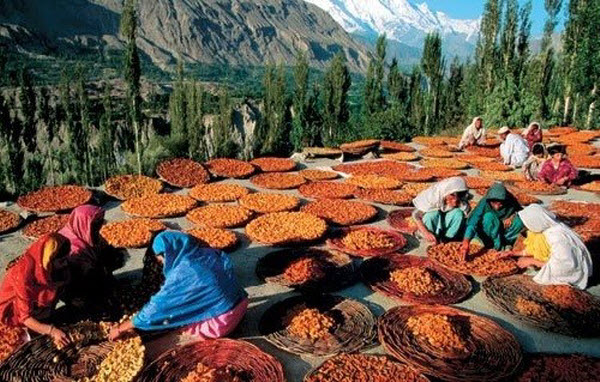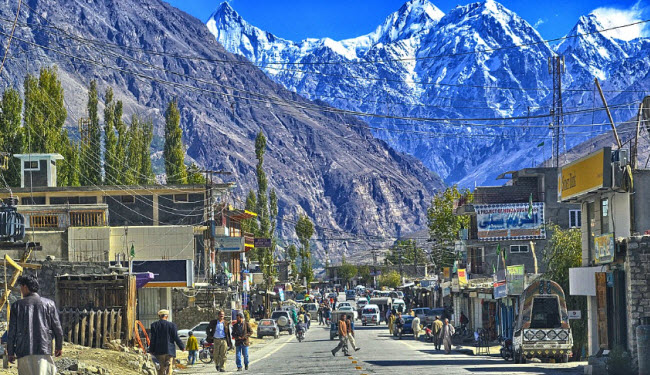In fictional stories, we often read about a place where people never get sick and live exceptionally long lives, sometimes reaching up to 150 years. Such descriptions might make readers wish to live in such a place. However, a little research shows that this fantasy might actually be a reality. This place exists in a mountainous valley with a river named Hunza flowing through it, located in the northern part of Pakistan near the border with China. This area, known as the “Oasis of Youth,” is home to the Hunza people, who are renowned for their unique characteristics, such as rarely suffering from diseases, maintaining perpetual youth, and having women who can conceive even at the age of sixty. Some reports suggest that the Hunza people are among the happiest in the world.



The Hunza people are known for their appearance, which resembles that of Europeans, and they speak several languages, with Burushaski being the most common. Most of them are Ismaili Muslims. They lead a simple life amidst lush agricultural landscapes, following a healthy diet. Their communities are free from violence and crime, focusing instead on agriculture, animal husbandry, participating in social events, and sports. Women’s roles traditionally revolve around childcare and household management. Interestingly, Hunza regions have the highest literacy rates in Pakistan. Despite a high unemployment rate, the people live in overall happiness, free from illnesses. Not only do they enjoy long lifespans, often exceeding 100 years, but women also give birth even in their sixties—a rarity anywhere else. They also practice bathing in icy water, with temperatures dropping to minus 15 degrees Celsius. These seemingly ideal conditions have attracted the attention of scientists, prompting them to study this unique community in hopes of uncovering the reasons behind these extraordinary phenomena.



After extensive research, scientists have concluded that several factors contribute to the well-being of the Hunza people. The first and foremost is their diet. Researchers observed that the Hunza fast during spring for periods ranging from 2 to 4 months. Apricots play a crucial role in their diet; they cultivate over 50 varieties in their valley, consuming them fresh in the summer, drying them for winter use, and even drinking apricot juice. This fruit is rich in vitamins, particularly vitamin B17, known for its potential to prevent and treat cancer. They also drink a traditional beverage made from a plant called Tumuro, which has been found to help regulate blood sugar levels and has antispasmodic properties. Its fruit is used as a stomach soother and dewormer, while its bark is used for dental hygiene and has properties that lower blood sugar. The Hunza eat only two meals a day, one at breakfast and the other after sunset. They consume food in moderation, taking only what they need, resulting in no cases of obesity among them. Their diet is free from artificial colors, flavors, or preservatives, and their crops, fruits, and grains are entirely free from pesticides, synthetic fertilizers, or genetically modified organisms. They also consume small amounts of cheese, yogurt, and meat.



The second factor contributing to the Hunza people’s well-being is their environment. The area they live in is free from air and soil pollution, and the water they use for drinking and farming comes from glacial runoff from the Himalayas, without any added chemicals like chlorine or fluoride. The third and final factor is their lifestyle. From a young age, Hunza children engage in physical activities and receive a high level of education. They do not use vaccinations in childhood and do not suffer from severe illnesses. It was also noted that the Hunza people do not use any form of technology, such as mobile phones or even televisions. As a result, they are a highly cohesive community, constantly interacting socially, which means they rarely experience feelings of isolation or depression, finding support and comfort from family and friends. They do not use chemicals in their homes or any plastic materials.



Despite these findings, some people argue that the idealized image of the Hunza community is exaggerated or even mythical. Some believe that these ideas inspired author James Hilton to write his 1933 novel “Lost Horizon,” which describes a utopian place in the Himalayas where people live long, disease-free lives. A Harvard Medical School physician supports this view, while others, like American journalist John Tierney, have disputed it. In a 1996 article for The New York Times, Tierney described his journey to the Hunza region. He acknowledged its enchanting beauty but suggested that the longevity claims of the elderly might be exaggerated. Without official birth records to verify these claims, it is challenging to confirm them. Furthermore, he observed that most of the elderly were not as healthy as popularly portrayed.
Regardless of the truth, the Hunza Valley represents a place that many people might dream of living in, even if only in their imagination.
